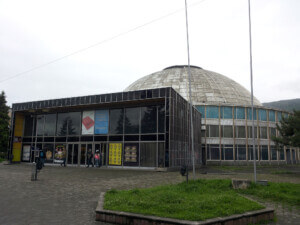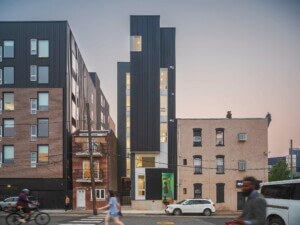The city of Philadelphia is moving forward with plans to demolish the beloved modernist stone pavilion in Columbus Square, affectionately referred to as the ‘Roundhouse’ (not to be confused with the Philadelphia Police Headquarters at 8th and Race Streets, also colloquially known as the ‘Roundhouse’). The building gained notoriety earlier this year when The Philadelphia Inquirer’s Inga Saffron attributed the building’s design to the late Elizabeth Hirsh Fleisher, the first woman architect in Philadelphia and one of the first in Pennsylvania. However, the Department of Parks and Recreation has expressed its doubt of Saffron’s claim, attributing the project to Fleisher’s partner Gabriel Roth instead. Some claim that the Roundhouse lacks historical significance without direct attachment to Fleisher, making it an easy target for demolition in the wake of a $2.8 million renovation of Columbus Square.
In a recent article for her column in the Inquirer, Saffron bluntly addressed the following questions: “Who’s right? And why should it matter at this late date?” Regardless of the architect’s identity, Saffron claims that the structure, which has been vacant since the city opened a larger recreational facility in 2005, deserves another chance. The whimsical modernist roof and hefty stone walls make it a unique time capsule from a bygone era, drawing parallels to Eero Saarinen’s MIT Chapel, which has long been praised as a treasure of mid-century modernism.
Since its completion in the 1960s, the Roundhouse served as an important center of community life for the surrounding neighborhood of Passyunk Square. Its single doorway opened into a small but inviting space in which park-goers could stop to rest, grab sporting equipment, and hold meetings. Even after years of vacancy, Passyunk Square residents have not forgotten the legacy of the Roundhouse; Philadelphia resident Jay Farrell launched a change.org petition to save the beloved pavilion, stating that “the Columbus Square Fleisher Pavilion is clearly a much-loved and familiar landmark in the Passyunk Square neighborhood of South Philadelphia and there is a strong desire among local residents to see it preserved and adaptively reused.” The petition has garnered over 2,500 signatures thus far.
While the future of the building remains unclear, the story of the Roundhouse has sparked important conversations about the unsung contributions of women architects and how we determine the historical significance of buildings.











